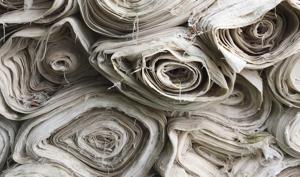- Clothes
- Bags
- Accessories
-
Inspiration
- Shoes
Tencel, Eucalyptus and Lyocell: What Are They, What's the Difference and Are They Sustainable Materials?

If you start looking into sustainable materials in the fashion industry, you’ll quickly come across TENCEL™. It’s a not so catchy name that doesn’t immediately reveal what the material actually is, or how eco-friendly it might be.
Even after a quick online search, you may find yourself reading about lyocell and eucalyptus, but that doesn’t make things a lot clearer.
So, in this blog, we’re diving into TENCEL™: what it is, whether it’s the same as lyocell, and what eucalyptus has to do with it.
And of course, since we’re Project Cece, we’ll also take a closer look at the environmental impact of this material.
What Is TENCEL™?
TENCEL™ is actually a brand name for Lyocell. Lyocell is a fabric that is made from wood pulp, most often eucalyptus trees.
The TENCEL™ material is produced by Lenzing, an Austrian company known for creating innovative fabrics based on wood from sustainably managed forests.
Are TENCEL™, Eucalyptus and Lyocell the Same?
Since TENCEL™ is a brand name for Lyocell, the two are essentially the same thing. Even though Lyocell is usually made from eucalyptus, Lyocell can also be made from other types of wood. Tencel*, on the other hand, is always made from eucalyptus trees.
So in short:
Tencel is always Lyocell made from eucalyptus wood, but Lyocell in general can be made from other wood types as well.
* We’ll switch to “Tencel” from here on, since writing it in all caps gets a bit shouty, but we’re still talking about TENCEL™!
How Is Tencel Made?
Tencel starts as eucalyptus wood, but you can imagine it takes a few steps before the strong eucalyptuswood is turned into the soft, wearable fabric. Here’s what that process looks like:
- The eucalyptus trees are (sustainably) harvested and chipped into small pieces.
- The wood chips are soaked in a solvent, breaking them down into a pulp-like liquid.
- That liquid is pushed through fine holes to create fibres.
- The fibres are dried and spun into yarn.
Is Tencel a Sustainable Material?
As with most fabrics in the fashion industry, Tencel has both pros and cons when it comes to sustainability.
Why Tencel is sustainable:
- The wood comes from certified, responsibly managed forests.
- The production uses a closed-loop system, meaning almost all water and solvents are recovered and reused.
- It uses less water than more popular crops like cotton.
- Production takes place in Europe, under stricter environmental regulations.
- Under the right conditions, Tencel is biodegradable.
Why Tencel isn’t always sustainable:
- It’s often blended with synthetic materials, which makes it no longer biodegradable.
- Even 100% Tencel items aren’t always compostable: they usually require industrial composting conditions.
Tencel in Practice: Bamboo Socks or Tencel Socks?
Tencel is used in all sorts of garments; from tops and trousers to underwear and socks.
A great example comes from Three Brothers, a brand that offers both socks made from bamboo and Tencel socks.
Like Tencel, bamboo also goes through a chemical process to become soft. Both fabrics have antibacterial properties, making them great for socks (say bye to sweaty feet!).
The difference lies in the production process. The processing of bamboo often doesn’t use a closed-loop system, meaning chemicals are not being reused as efficiently as possible and can even leak into water and soil, polluting the surroundings.
Tencel, on the other hand, is made in a closed-loop system where 99.5% of the water and chemicals are reused.
Both bamboo and Tencel are durable fabrics, which also adds to their sustainability. The longer your socks last, the fewer you need to buy and the less needs to be produced.

Three Brothers’ Eucalyptus Socks are made from Tencel, recycled polyamide and elastane, and are available per pair, in sets of 3, or in sets of 7.
Conclusion
Tencel is a soft, comfortable and durable material with lots of positive qualities, both in its production process and how it feels to wear. Many people see it as one of their favourite sustainable fabrics out there.
The most sustainable fabric, of course, will always be the one that’s already in your wardrobe.
But.. if you’re looking for brands that are committed to a fairer and more eco-friendly fashion industry, you’ll find products from over 350 small fashion brands all in one place on Project Cece.
The goal? Making it easy to find clothing that matches both your style and your values.
Share our story
Related articles
5 Ethical Fashion Brands Taking Stances & Being Activists
Fast fashion keeps using sweatshops & unethical practices. So, because we could all do with some hope, here are 5 brands taking stances & creating positive impact!
Is Deadstock Fabric Sustainable or Is It Greenwashing?
Many companies pride themselves in using leftover textiles, but is deadstock fabric as sustainable as they claim or just another form of greenwashing? Let’s see.
Explainer: What is GOTS and Does it Guarantee Sustainable Fashion?
With so many certificates available in the fashion industry, you almost need a PhD to keep track of what every single one of them means. Although we have a comprehensive list of certificates in sustainable fashion available, it can still be a challenge to remember what each of them stands for. Today, we’re changing that! In this blog, we zoom in on one of our favourite sustainability certifications in the fashion industry: the Global Standard for Organic Textiles, also known as GOTS. (In our heads, we always have the halo sound whenever we read that and we think it’s a certificate that’s actually THAT good).
Project Cece is a platform that collects ethical fashion from vetted brands and shops in one place. Browse ethical fashion for women and men and find items that fit your style, budget and values!


